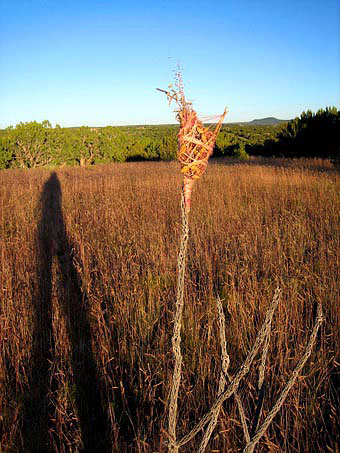Yesterday I posted on the UN International Year of the Forests .... I know many of you will be hyper-aware of just why this is so critical! I added the question of what could we bring to this year to impact things for the greater good... and suggested there are multiple ways to apply our skills and ingenuity, our ideas and effort.
I thought I would post this story which I've titled "Wearable Gardens"... just to bring home how left field some ideas might be... but to place value on the fact of attracting attention ... in a brilliantly eye-catching way .... to a profoundly important matter.
This comes from
ecouterre on wearable technology. (Click on ecouterre title to read more)
“Pollinator Frocks” Are Wearable Gardens That Attract, Feed Hungry Bees
by Jasmin Malik Chua, 01/17/11

Artist Karen Ingham’s latest project is guaranteed to make a buzz. The British insect-lover has produced a series of dresses designed to aid shrinking populations of bees and other pollinators, a growing environmental crisis that threatens our global food system. Featuring electron-microscopy images of pollen, Ingham’s “Pollinator Frocks” are treated with a nectar-like sugar solution that attracts and nourishes bees and their brethren. She even created outfits for separate occasions: day-wear to draw bees and butterflies and evening-wear for nocturnal critters such as moths.

FROCKS THAT ROCK
“Populations of insect pollinators such as bees, butterflies, and moths, and the plants on which they depend, are declining at alarming rates due to deleterious human activity,” says Ingham, who collaborated with entomologists, botanists, microscopists, and engineers to develop her prototypes. “These symbiotic relationships must be protected.”Treated with a nectar-like sugar solution, the dresses mimic the way insects relate to flowers.
Working with technologists at the Welsh Centre for Printing and Coating, Ingham examined aromas and materials that mimic the way insects relate to flowers before settling on her arresting printed fabrics, which she dubs “wearable gardens.” Ingham sees her dresses having the most impact in urban spaces, where gardens are limited in number, nectar-rich plants are rare, and public engagement is most needed. “The clothing can be hung out as clothes are hung on a washing line, to act as an attractant to pollinators,” she says.+ Pollinator Frocks
+ Karen Ingham
UPDATE: Hop over to erudite eco-wise woman India to see what she noticed when viewing the above video. As one well aquainted with the workings of nature ... biological and chemical processes ... especially in relation to textiles ... she immediately picked up on question marks in the thinking of this project.
So perhaps we have a successful attention-grabbing project with a not so likely application! Note to self: read the fine print! Thanks India... always much to learn and revel in at her blog Prophet of Bloom!
Also from this fabulous site which is well worth a visit....
Coffee beans are actually the seed of the plant. so how does one make clothes from coffee beans?
Take a good look at this and read more here at Ecouterre.
S.Cafe: Clothes Made From Used Coffee Grounds
by Jasmin Malik Chua, 10/01/09

Photo by deapeajay
S.CAFE \ˈes ka-ˈfā\
n. 1 a: A fabric that Singtex Industries in Taiwan knits or weaves using waste coffee grounds. (A single cup of coffee can yield two shirts.) b: Said to dry quickly, protect against UV rays, and neutralize odors. c: Meets Swiss Bluesign standards for sustainable fabrics.+ S.Cafe
So...what can we bring to 2011?
I'd say our curiosity and willingness to take a look at some great new ideas... and even if not convinced to purchase a coffee ground T-shirt... at least we can celebrate that people are out there are getting very serious about pushing the envelope.
Would I like wear the pollinator frock?
well ... I'm a little uncomfortable with the idea of bees buzzing around me as I walk along... BUT... I do think this is a powerful message to put out there... and in the halls of fashion... yes please... bring the message to the masses....
these stories came through INHABITAT - an e-mag that believes design will save the world. Go visit and see what they are up to!















![heracliteanfire:
uncertaintimes: thethirdmind: Materia Medica of Vegetable Origin [via]](http://sophiemunns.tumblr.com/photo/1280/2581323026/1/O98B60FOopsqc9fhaFjOxQJB)


















